- Like
- Digg
- Tumblr
- VKontakte
- Buffer
- Love This
- Odnoklassniki
- Meneame
- Blogger
- Amazon
- Yahoo Mail
- Gmail
- AOL
- Newsvine
- HackerNews
- Evernote
- MySpace
- Mail.ru
- Viadeo
- Line
- Comments
- SMS
- Viber
- Telegram
- Subscribe
- Skype
- Facebook Messenger
- Kakao
- LiveJournal
- Yammer
- Edgar
- Fintel
- Mix
- Instapaper
- Copy Link
Several months ago our oldest worked on a fun project to go along with one of the chapters in her North Star Geography curriculum. We’ve mentioned several times that this class was one of her favorite classes last year, particularly because it included many hands-on activities as a part of the curriculum.
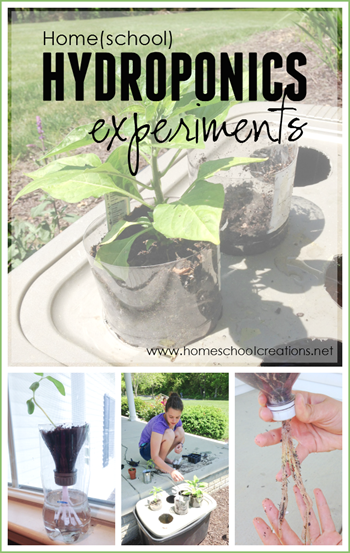

The second part of the year involved learning about agriculture and building a home hydroponics system (lesson 12). Laurianna decided to build two different types of hydroponic systems as part of her hands-on projects, one fairly simple system that used an empty soda bottle with yarn (to absorb the water from the bottom of the bottle) and another more elaborate system that involved some help for her dad to cut the lid of the bin she used. You can see the various ideas for home hydroponics systems here that she gathered while looking for systems to build.
Soda Bottle Hydroponic System
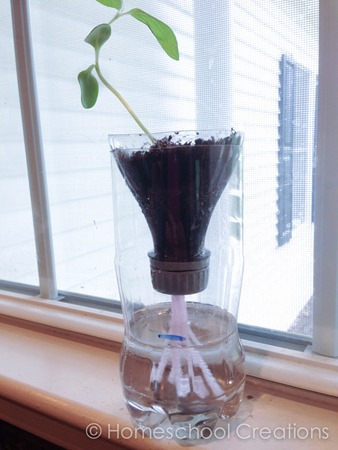
After looking through the different ideas online, Laurianna started with a simple soda bottle hydroponic system based on this pin. The pieces needed to get started were very easy to find:
-
an empty soda bottle
-
yarn
-
potting soil
-
seed or seedling
-
water
Laurianna cut the small soda bottle and inverted the top section into the lower section. She poked several holes through the cap of the bottle and threaded yarn through the holes, making sure they were long enough to be immersed in the water. The top part of the bottle was filled with potting soil and her seedling.
On the side of the bottle you may notice a blue line. This was her water gauge line to make sure the water was at a high enough level for the yarn to absorb the water. If it was below the line too much, the yarn had difficulty feeding the plant.
This was a super-easy system to implement and she was able to work on it independently and complete in a fairly short time frame as well. The hardest part for us was finding a good window with light to keep the plant growing well because many of our window sills are not quite wide enough to perch the bottle without the danger of someone knocking it off and making a huge mess.
Plastic Bin Home Hydroponic System
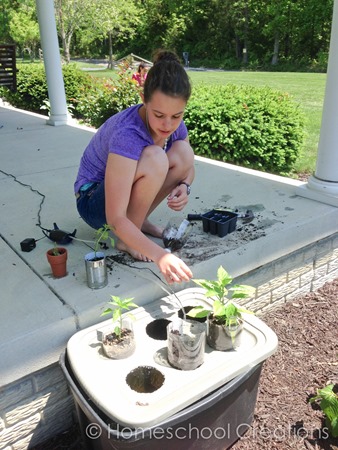
Based on an idea from this pin, Laurianna built a larger hydroponics system in a plastic bin using the following items:
-
a 10 gallon plastic bin with lid
-
3 empty soda bottles (cut in half)
-
yarn
-
potting soil
-
6 pepper plants
-
air filter our old fish tank
-
water
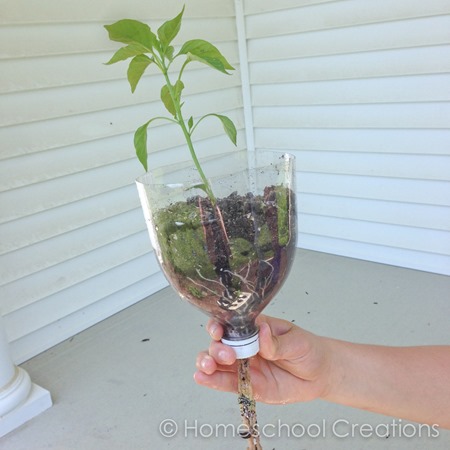
above you can see the yarn that she fed out through holes in the lid
My husband, Rick, helped Laurianna cut the holes in the plastic lid of the bin because it was a little tricky (and we also wanted to be sure all of her fingers and appendages were still in place at the end of the project. Laurianna then cut each soda bottle in half and poked holes in the caps of the tops of the bottle or holes in the bottoms of the bottles to thread yarn through (similar to this idea here). Once the yarn was threaded through, she filled the bottle half with potting soil and planted a seedling in the bottle.
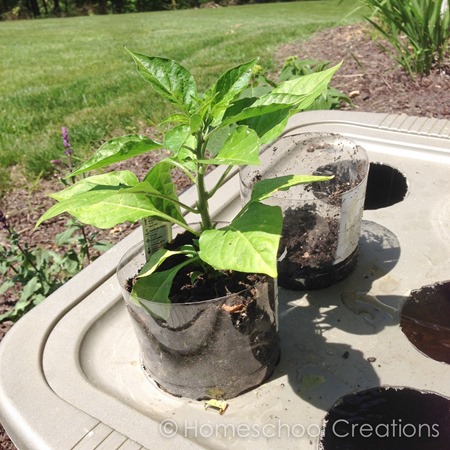
Water was added to the base of the bin and plant bottles were placed into the six holes of the bin lid. Laurianna measure to see how high the water needed to be in the bin so the yarn coming from the bottle bases would touch and absorb the water. At least half of the yarn needed to be in the water or it wouldn’t absorb well.
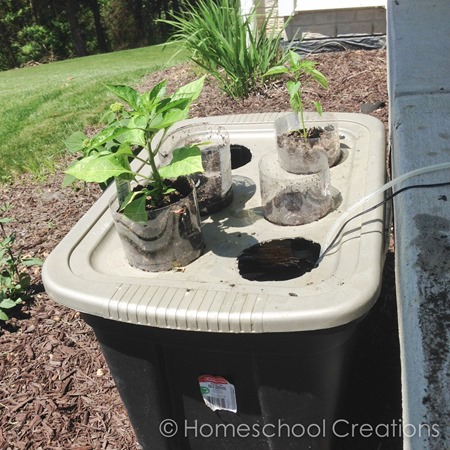
The fish tank filter was added about a week after she started the experiment because the yarn wasn’t being oxygenated enough. To add the filter, she cut a small hole in the side of the bin and fed the filter through the side of the bin. That helped tremendously (she was hoping to get by without needing it).
The plastic bin hydroponics system was definitely more complicated to put together (although complicated is fine in her book), and it yielded some great a results. All six of the plants began to thrive once the water filter was added to the bin and were later transferred to our garden when they were budding and large enough to grow peppers. Since their transfer to the garden they have been producing like crazy and Laurianna is now in habanero and cayenne pepper heaven. (grins)
Hydroponic System Results
The soda bottle hydroponics system was simple to make and overall worked well for the one plant that she grew using this method. Unfortunately someone (namely a high schooler) forgot to put water in the base of the bottle when we left for vacation, and the plant dried up and died while we were gone. The water in the bottle base needed to remain at a certain level or the yarn wouldn’t absorb the water correctly, so no water = a not happy plant that shriveled up to nothing.
The plastic bin hydroponics system was by far the favorite method of growing plants although it did require a bit more work (and cleanup – especially because salamanders seemed to think it was a fabulous place to crawl into and die). Most likely results were skewed based on the massive amounts of spicy peppers that were produced as well, but Laurianna was definitely proud of the work she put into it.
Overall the projects were both successful and now other children in the house are now anxious to have their turn at North Star Geography – and you have to love that! Quite honestly, it has me thinking about ways that we can better grow some of our favorite plants (or continue growing) through the winter months with a little less care on our part – so maybe it was good for everyone in the family.
Have you tried hydroponics at home and found a method that works well for you?
Find out more about North Star Geography HERE.
We used the hardcover version of North Star Geography and are thrilled to see it is now also available as an online course from Bright Ideas Press! The new self-paced option also includes audiobook and instructor help!




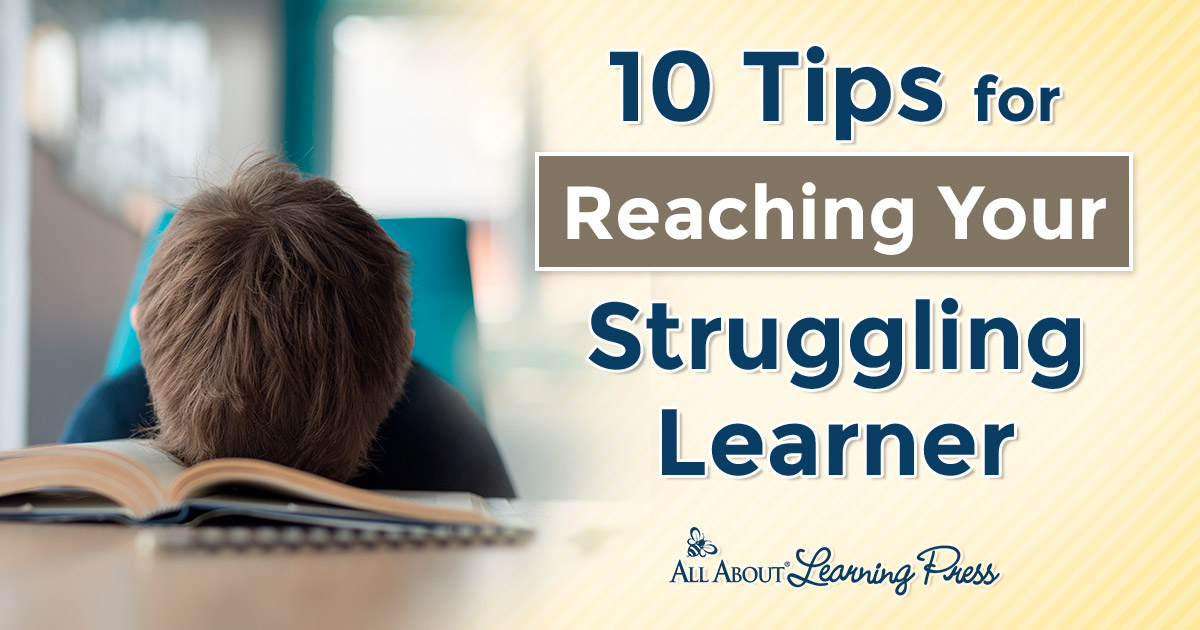




 The printables shared on this site are FREE of charge unless otherwise noted, and you are welcome to download them for your personal and/or classroom use only. However, free or purchased printables are NOT to be reproduced, hosted, sold, shared, or stored on any other website or electronic retrieval system (such as Scribd or Google docs). My printables are copyright protected and I appreciate your help in keeping them that way.
If you download and use some of my printables and then blog about them, please provide a link back to my blog and let me know - I'd love to see how you are using them! Please be sure to link to the blog post or web page and not directly to the file itself. Thank you!
The printables shared on this site are FREE of charge unless otherwise noted, and you are welcome to download them for your personal and/or classroom use only. However, free or purchased printables are NOT to be reproduced, hosted, sold, shared, or stored on any other website or electronic retrieval system (such as Scribd or Google docs). My printables are copyright protected and I appreciate your help in keeping them that way.
If you download and use some of my printables and then blog about them, please provide a link back to my blog and let me know - I'd love to see how you are using them! Please be sure to link to the blog post or web page and not directly to the file itself. Thank you!
Leave a Comment
You must be logged in to post a comment.